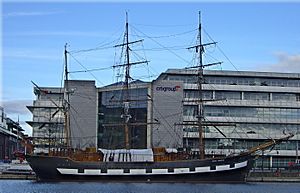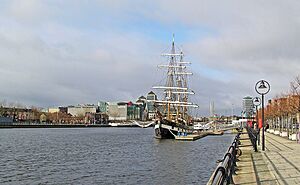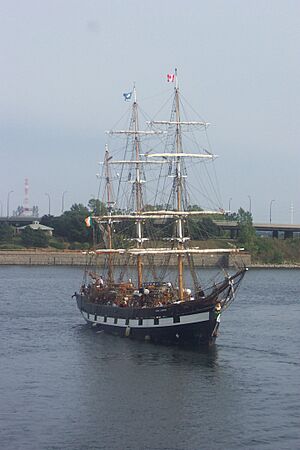Jeanie Johnston facts for kids

Jeanie Johnston, moored off Custom House Quay, Dublin
|
|
Quick facts for kids History |
|
|---|---|
| Name | Jeanie Johnston |
| Owner | Dublin Docklands Development Authority |
| Operator | Aiseanna Mara Teoranta |
| Port of registry | Tralee, County Kerry |
| Builder | The Jeanie Johnston (Ireland) Company Ltd., Blennerville, Tralee |
| Cost | €13.7m |
| Laid down | 1998 |
| Launched | 6 May 2000 |
| Sponsored by | President Mary McAleese |
| Christened | 7 May 2000 |
| Completed | 2002 |
| Maiden voyage | March 2003 |
| Identification |
|
| Status | Museum ship |
| General characteristics | |
| Type | Three-masted barque |
| Tonnage | 301 GT |
| Displacement | 518 t (510 long tons) |
| Length |
|
| Beam | 8 m (26 ft 3 in) |
| Height | 28 m (91 ft 10 in) air draft |
| Draft | 4.6 m (15 ft 1 in) |
| Installed power |
|
| Propulsion |
|
| Sail plan |
|
| Endurance |
|
| Crew | 40 (11 permanent and 29 voyage crew) |
The Jeanie Johnston is a replica of a three-masted barque, which is a type of sailing ship. The original ship was built in Canada in 1847. Today, the replica Jeanie Johnston does many things. It's a sail training vessel where people learn to sail. When it's in port, it becomes a living history museum. Visitors can learn about people moving from Ireland in the 1800s. Sometimes, it's also used for special events.
Contents
The First Jeanie Johnston Ship
The first Jeanie Johnston was bought by a company in Tralee, Ireland. It was a cargo vessel that sailed between Tralee and North America. The ship would carry people from Ireland to North America. Then, it would bring timber (wood) back to Europe.
Voyages During the Great Famine
The Jeanie Johnston made its first trip from County Kerry to Quebec, Canada, on April 24, 1848. At that time, 193 people were on board. This was during the Great Famine, a very difficult time in Ireland. Between 1848 and 1855, the Jeanie Johnston made 16 trips across the Atlantic Ocean. It sailed to Quebec, Baltimore, and New York. Each trip usually took about 47 days.
The most people it ever carried was 254. This was on a trip from Tralee to Quebec in 1852. To compare, the replica ship today can only carry 40 people, including the crew.
A Ship with a Perfect Safety Record
What makes the Jeanie Johnston special is that no one ever died on board during its voyages. This was true for both the crew and the passengers. This was very different from other ships at the time, which were sometimes called "coffin ships" because so many people died on them.
People believe the Jeanie Johnston was so safe for a few reasons. The captain, James Attridge, made sure the ship was not too full. Also, a trained doctor, Richard Blennerhassett, was always on board to help the passengers.
In 1855, the ship was sold to a new owner in England. In 1858, while carrying timber to Quebec, it started to fill with water. The crew had to climb high into the rigging (the ropes and masts). After nine days, they were rescued by a Dutch ship. Even when it sank, the Jeanie Johnston kept its perfect safety record.
The Replica Ship Today
How the Replica Was Built

The idea to build a copy of the Jeanie Johnston started in the late 1980s. The design for the ship was created by Fred Walker, a naval architect. Building the ship was a big project. A team of young people from different countries, including Ireland, the United States, and Canada, helped build it. They worked with experienced shipwrights (ship builders).
The ship's hull (the main body) was made from larch wood planks on oak frames. The decks were built using iroko and Douglas-fir wood. The masts and spars (poles for sails) were also made from Douglas fir.
Modern Features for Safety
To meet today's international safety rules, the replica Jeanie Johnston has some modern parts. It has two powerful Caterpillar engines and two generators. It also has a bow thruster, which helps it move easily in lakes and rivers. For safety, it has strong steel walls inside called bulkheads that stop water from spreading. It also has special valves and fire-fighting equipment. This means it meets the highest safety standards for modern passenger ships.
During construction, builders found that the ship might float too high in the water. To fix this, a steel keel (a long piece at the bottom of the ship) was added below the original wooden one. This makes the Jeanie Johnston sit deeper in the water. Because of this, it cannot visit some ports that the original ship could. However, this change also makes the ship very stable, even in strong storms at sea. On its first trip to America in 2003, it sailed through a very strong storm and was perfectly fine.
Launching the Ship
The ship was supposed to be launched from its shipyard in Blennerville. But an old shipwreck was found there, so the plans changed. On April 19, 2000, the hull of the Jeanie Johnston was moved onto a special barge. Its masts and sails were added there. On May 4, it was taken to Fenit. Two days later, on May 6, the barge was lowered into the water, and the Jeanie Johnston floated for the very first time. The next day, President of Ireland Mary McAleese officially named the ship.
The Ship's Journeys and Life Today
In 2003, the replica Jeanie Johnston sailed from Ireland to Canada and the United States. It visited 32 cities and welcomed over 100,000 visitors. In 2005, it took part in the Tall Ships Race from Waterford to Cherbourg.
The replica ship is currently owned by the Dublin Docklands Development Authority. They bought it in 2005. From 2006 to 2008, another company operated the ship. During that time, it carried many people learning to sail and thousands of passengers. It often visited ports around Britain and Ireland. It also made trips to Spain in the summer.
In 2009, there was a disagreement about who would operate the ship. The Jeanie Johnston was offered to the Department of Defence for training, but they turned it down. They said it wasn't fast enough and needed too many crew members.
A new operator was found in 2010, and the ship became a museum. In 2011, some water damage was found. Repairs were not done for three years because there wasn't enough money. As of 2015, more money was needed to make the ship ready for ocean voyages and training again. Running the ship as a museum costs about €240,000 each year. Ticket sales help cover some of these costs.
Images for kids






